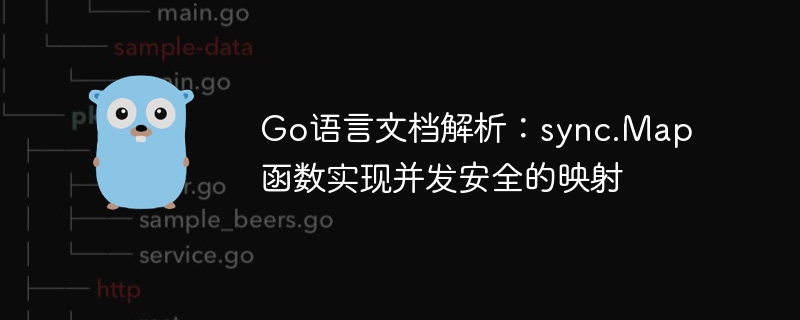

Go language is a programming language that has become very popular among front-end developers in recent years. Among them, the sync.Map function is designed to achieve concurrency-safe mapping, which can help developers solve data access problems that occur under high concurrency. This article will introduce how to use the sync.Map function and provide specific code examples.
1. Overview of sync.Map function
The sync.Map function is a concurrent and safe mapping type in the Go language standard library. It can be used for data sharing between multiple coroutines (ie Goroutine) to achieve thread-safe data access. In high concurrency scenarios, using the sync.Map function can effectively improve the concurrent processing capabilities of the program and avoid program crashes due to data access problems.
2. How to use the sync.Map function
When using the sync.Map function, we need to initialize it first. The initialization code is as follows:
var map1 sync.Map
Next, we can use the following method to operate on the sync.Map object:
This method Used to put key-value pairs into a sync.Map object. The sample code is as follows:
map1.Store("key1","value1")This method is used to obtain the corresponding value from the sync.Map object based on the specified key. The sample code is as follows:
value,ok := map1.Load("key1")
if ok {
//值存在
fmt.Println(value)
} else {
//值不存在
fmt.Println("key1 not found")
}This method is used to first try to get the value from the sync.Map object. If it does not exist, the specified key-value pair will be used. Save object. The sample code is as follows:
value,ok := map1.LoadOrStore("key2","value2")
if ok {
//值存在
fmt.Println(value)
} else {
//值不存在
fmt.Println("key2 not found")
}This method is used to delete the key-value pair specified in the sync.Map object. The sample code is as follows:
map1.Delete("key1")This method is used to traverse all key-value pairs in the sync.Map object. Its first parameter is a function that operates on key-value pairs. The sample code is as follows:
map1.Range(func(key, value interface{}) bool {
fmt.Printf("key:%v, value:%v
", key, value)
return true
})3. Code example
The following is a complete sample code that demonstrates how to use the sync.Map function to implement concurrent and safe mapping. The specific code is as follows:
package main
import (
"fmt"
"sync"
)
func main() {
var map1 sync.Map
//添加键值对
map1.Store("key1", "value1")
map1.Store("key2", "value2")
map1.Store("key3", "value3")
//获取指定键的值
value, ok := map1.Load("key1")
if ok {
fmt.Println(value)
} else {
fmt.Println("key1 not found")
}
//获取不存在的键的值
value, ok = map1.Load("key4")
if ok {
fmt.Println(value)
} else {
fmt.Println("key4 not found")
}
//尝试获取不存在的键的值时,存入指定的键值对
value, ok = map1.LoadOrStore("key4", "value4")
if ok {
fmt.Println(value)
} else {
fmt.Println("key4 not found")
}
//获取删除之前的值
value, ok = map1.Load("key4")
if ok {
fmt.Println(value)
} else {
fmt.Println("key4 not found")
}
//删除指定的键值对
map1.Delete("key4")
//遍历所有键值对
map1.Range(func(key, value interface{}) bool {
fmt.Printf("key:%v, value:%v
", key, value)
return true
})
}The above code demonstrates the use of multiple methods of the sync.Map function, including Store, Load, LoadOrStore, Delete and Range. In high-concurrency scenarios, these methods can help developers better implement concurrent and safe mapping operations, improve the program's concurrent processing capabilities, and avoid program crashes due to data access.
The above is the detailed content of Go language document analysis: sync.Map function implements concurrent and safe mapping. For more information, please follow other related articles on the PHP Chinese website!
 Usage of Type keyword in Go
Usage of Type keyword in Go
 How to implement linked list in go
How to implement linked list in go
 What are the Go language programming software?
What are the Go language programming software?
 How to learn go language from 0 basics
How to learn go language from 0 basics
 What are the methods to implement operator overloading in Go language?
What are the methods to implement operator overloading in Go language?
 What are the operators in Go language?
What are the operators in Go language?
 plugin.exe application error
plugin.exe application error
 How to solve the problem of vs2008 installation failure
How to solve the problem of vs2008 installation failure




